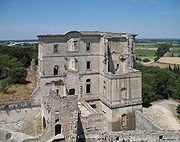
Montmajour Abbey
Encyclopedia

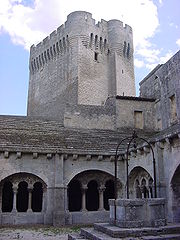
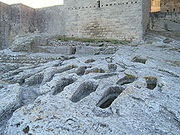

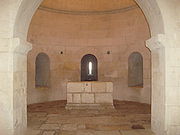

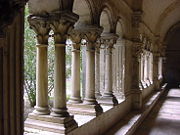


Abbey
An abbey is a Catholic monastery or convent, under the authority of an Abbot or an Abbess, who serves as the spiritual father or mother of the community.The term can also refer to an establishment which has long ceased to function as an abbey,...
(French: Abbaye Notre Dame de Montmajour) is a fortified Benedictine
Benedictine
Benedictine refers to the spirituality and consecrated life in accordance with the Rule of St Benedict, written by Benedict of Nursia in the sixth century for the cenobitic communities he founded in central Italy. The most notable of these is Monte Cassino, the first monastery founded by Benedict...
monastery built between the 10th and 13th century on what was then an island five kilometers north of Arles
Arles
Arles is a city and commune in the south of France, in the Bouches-du-Rhône department, of which it is a subprefecture, in the former province of Provence....
, in the Bouches-du-Rhône
Bouches-du-Rhône
Bouches-du-Rhône is a department in the south of France named after the mouth of the Rhône River. It is the most populous department of the Provence-Alpes-Côte d'Azur region. Its INSEE and postal code is 13.-History of the department:...
département, Provence
Provence
Provence ; Provençal: Provença in classical norm or Prouvènço in Mistralian norm) is a region of south eastern France on the Mediterranean adjacent to Italy. It is part of the administrative région of Provence-Alpes-Côte d'Azur...
, in the south of France
France
The French Republic , The French Republic , The French Republic , (commonly known as France , is a unitary semi-presidential republic in Western Europe with several overseas territories and islands located on other continents and in the Indian, Pacific, and Atlantic oceans. Metropolitan France...
.
The Abbey is noted for its 11th-14th century grave
Grave (burial)
A grave is a location where a dead body is buried. Graves are usually located in special areas set aside for the purpose of burial, such as graveyards or cemeteries....
s, carved in the rock, its subterranean crypt
Crypt
In architecture, a crypt is a stone chamber or vault beneath the floor of a burial vault possibly containing sarcophagi, coffins or relics....
, and its massive unfinished church. It was an important pilgrimage site during the Middle Ages, and in the 18th century it was the site of a large Maurist Monastery
Monastery
Monastery denotes the building, or complex of buildings, that houses a room reserved for prayer as well as the domestic quarters and workplace of monastics, whether monks or nuns, and whether living in community or alone .Monasteries may vary greatly in size – a small dwelling accommodating only...
, now in ruin. The abbey is cared for as a historic monument by the Centre des monuments nationaux
Centre des monuments nationaux
The Centre des monuments nationaux is a French government body which conserves, restores, and manages historic buildings and sites which are the property of the French state...
.
Early History and Legends of Montmajour
Until the late Middle Ages Montmajour was an island, 43 meters high, surrounded by marshes and accessible only by boat. Beginning in the third millennium BC the island was used as a cemetery, with individual graves carved into the rock. In the 9th and 10th centuries the island also served as a sanctuary for the local residents during invasions of the Saracens and the NormansNormans
The Normans were the people who gave their name to Normandy, a region in northern France. They were descended from Norse Viking conquerors of the territory and the native population of Frankish and Gallo-Roman stock...
.
During the Middle Ages, several legends arose about Montmajour and its founding. One legend said that the island had been the sanctuary of St. Trophimus, who had been sent from Rome by St. Peter to convert the Gauls
Gauls
The Gauls were a Celtic people living in Gaul, the region roughly corresponding to what is now France, Belgium, Switzerland and Northern Italy, from the Iron Age through the Roman period. They mostly spoke the Continental Celtic language called Gaulish....
. After coming to Arles in 46 AD, he took shelter in one of the caves on the island and received disciples there. A rock cell under the church is called "The Confessional of St. Trophimus."
Another legend said that the graves were those of soldiers of Charlamagne, who had fought against the Saracens. A third legend said that the first church was founded by King Childebert I
Childebert I
Childebert I was the Frankish king of Paris, a Merovingian dynast, one of the four sons of Clovis I who shared the kingdom of the Franks upon their father's death in 511...
, the son of Clovis
Clovis I
Clovis Leuthwig was the first King of the Franks to unite all the Frankish tribes under one ruler, changing the leadership from a group of royal chieftains, to rule by kings, ensuring that the kingship was held by his heirs. He was also the first Catholic King to rule over Gaul . He was the son...
, when he saw fervor of a group of anchorite
Anchorite
Anchorite denotes someone who, for religious reasons, withdraws from secular society so as to be able to lead an intensely prayer-oriented, ascetic, and—circumstances permitting—Eucharist-focused life...
hermits on the island.
Chronology
- 943 - A Frankish noblewoman, Teucinde, acquires the island from the Church of St. TrophimeChurch of St. TrophimeThe Church of St. Trophime is a Roman Catholic church and former cathedral built between the 12th century and the 15th century in the city of Arles, in the Bouches-du-Rhône Department of southern France...
in Arles, and leaves it in her will to a group of monks, with instructions to create an Abbey following the Rule of St. Benedict.
- 963- Pope Leo VIIIPope Leo VIIIPope Leo VIII , a Roman by birth, is considered by the Church an Antipope from 963 to 964 and a true Pope from 964 to 965. He held the lay office of protoserinus when he was elected pope by the Roman synod in December 963, when it also invalidly deposed Pope John XII , who was still alive...
puts the Abbey under his direct patronage.
- 11th Century - St. Peter's Chapel is constructed into the rock on the south side of the hill, near the cemetery.
- 1030- The Abbey acquires what is believed to be a fragment of the True CrossTrue CrossThe True Cross is the name for physical remnants which, by a Christian tradition, are believed to be from the cross upon which Jesus was crucified.According to post-Nicene historians, Socrates Scholasticus and others, the Empress Helena The True Cross is the name for physical remnants which, by a...
. A chapel of the Abbey church is dedicated to the relic, and the church becomes a major pilgrimage site. AbsolutionAbsolutionAbsolution is a traditional theological term for the forgiveness experienced in the Sacrament of Reconciliation. This concept is found in the Roman Catholic Church, as well as the Eastern Orthodox churches, the Anglican churches, and most Lutheran churches....
for their sins is given to all who come there on May 3, feast day for the Discovery of the True Cross, and leave a donation for the completion of the Abbey. By the 12th century the pilgrimage had become so popular that the Abbey had to build a separate church, the Chapel of the Holy CrossChapel of the Holy CrossThe Chapel of the Holy Cross is a Roman Catholic chapel built into the mesas of Sedona, Arizona, which was inspired and commissioned by sculptor Marguerite Brunswig Staube, student of Frank Lloyd Wright. Richard Hein was chosen as project architect, and the design was executed by architect August...
, for the relic.
- 12th Century - The Abbey is at the peak of its influence and wealth. It possesses vineyards, cornfields, olive groves, waterways, mills, fisheries and forests, and has dependent priories and land all over Provence, and as far away as FrejusFréjusFréjus is a commune in the Var department in the Provence-Alpes-Côte d'Azur region in southeastern France.It neighbours Saint-Raphaël, effectively forming one town...
, SisteronSisteronSisteron is a commune in the Alpes-de-Haute-Provence department in the Provence-Alpes-Côte d'Azur region in southeastern France.Sisteron is situated on the banks of the River Durance just after the confluence of the rivers Buëch and Sasse...
and GrenobleGrenobleGrenoble is a city in southeastern France, at the foot of the French Alps where the river Drac joins the Isère. Located in the Rhône-Alpes region, Grenoble is the capital of the department of Isère...
. The rulers of Provence give the Abbey land, castles, and even entire towns, such as PertuisPertuisPertuis is a commune in the Vaucluse department in the Provence-Alpes-Côte d'Azur region in southeastern France.Located south of the Luberon, this town is also near Aix-en-Provence, a famous town. Pertuis has existed since at least 981, while a castle was first built in the 12th century...
.
- Construction of the Abbey Church of Our Lady is begun, but because of a shortage of money, only the first two bays are completed.
- 13th Century - The Abbey has sixty resident monks, a large number for the Middle Ages.
- 1348 - The Black Plague reduces by half the population of Provence.
- 1357 - The Grandes Compagnies, armies of French soldiers left unpaid after the French defeat by the EnglishEnglandEngland is a country that is part of the United Kingdom. It shares land borders with Scotland to the north and Wales to the west; the Irish Sea is to the north west, the Celtic Sea to the south west, with the North Sea to the east and the English Channel to the south separating it from continental...
at PoitiersPoitiersPoitiers is a city on the Clain river in west central France. It is a commune and the capital of the Vienne department and of the Poitou-Charentes region. The centre is picturesque and its streets are interesting for predominant remains of historical architecture, especially from the Romanesque...
during the Hundred Years War, ravage the countryside. The countryside was pillaged again by marauders in 1357, and by the soldiers of Raymond de Turenne of Les Baux, who waged war against Arles from 1386 to 1398. The Abbot of Montmajour, Pons de L'Orme, fortifies the monastery with a massive tower. Widespread starvation and destruction in Provence.
- 1593 -During the Wars of ReligionFrench Wars of ReligionThe French Wars of Religion is the name given to a period of civil infighting and military operations, primarily fought between French Catholics and Protestants . The conflict involved the factional disputes between the aristocratic houses of France, such as the House of Bourbon and House of Guise...
, the Abbey is occupied by soldiers of the Catholic LeagueCatholic League (French)The Catholic League of France, sometimes referred to by contemporary Roman Catholics as the Holy League, a major player in the French Wars of Religion, was formed by Duke Henry of Guise in 1576...
, and the monks are forced to move to Arles for two years. When they return, they find the monastery ruined.
- 1639 Against the wishes of the majority of monks, the Abbey is given to a new order, the MauristsMauristsThe Congregation of St. Maur, often known as the Maurists, were a congregation of French Benedictines, established in 1621, and known for their high level of scholarship...
, a reformed Benedictine order based at the Abbey of Saint-Germain-des-PrésAbbey of Saint-Germain-des-PrésThe Benedictine Abbey of Saint-Germain-des-Prés, just beyond the outskirts of early medieval Paris, was the burial place of Merovingian kings of Neustria...
in Paris. Despite the hostility of the "old" monks, and of the Abbot, Charles Bichi, whose family had purchased his title from the King, who did not reside at the Abbey and refused to pay for its upkeep, the Maurists began a program of restoration and construction.
- Though the Maurists monks numbered only thirty, their construction program was grandiose - they began a classical building designed to have twenty-five bays along its north and south facades. Sixteen bays were completed by the time of the French Revolution.
- 1786- the titular Abbot, Cardinal Louis de Rohan, refuses to pay for any more upkeep of the Abbey. The Abbey is officially secularized.
- 1789 -At the time of the French Revolution, only nine monks remain at Montmajour.
- 1791-1793 The monastery is sold for 62,000 livres to Elizabeth Roux-Chatelard, who strips the Maurist building and leaves it in ruins. The property is then resold to twenty different owners. The medieval part is used for a sheep farm and haylofts.
- 1797- the painter Jacques RéattuJacques RéattuJacques Réattu was a French painter and winner of the grand prix de Rome. He was an illegitimate son of the painter Guillaume de Barrême de Châteaufort and Catherine Raspal, sister of the Arles-born painter Antoine Raspal - Antoine gave him his first lessons in painting.In Paris, in 1773 he was a...
buys the Pons de l'Orme tower, saving it from destruction.
- 1822- The city of Arles buys the Chapel of the Holy Cross from a fisherman, and preserves it.
- 1840- the writer Prosper MériméeProsper MériméeProsper Mérimée was a French dramatist, historian, archaeologist, and short story writer. He is perhaps best known for his novella Carmen, which became the basis of Bizet's opera Carmen.-Life:...
, inspector of ancient monuments, puts the Abbey on the first list of French historical monuments which should be preserved. Restoration begins on some of the buildings in 1862, and continues for decades.
- 1859- The last of the romanesque and gothic properties are purchased by the state. The Maurist building is not purchased until 1921.
- 1944 - a major fire breaks out inside the abbey church, which is being used by the German Army as an arms depot.
St. Peter's Chapel (11th Century)
St. Peter's chapel is the oldest existing part of the Abbey, probably built between 1030 and 1050. It consists of a narthexNarthex
The narthex of a church is the entrance or lobby area, located at the end of the nave, at the far end from the church's main altar. Traditionally the narthex was a part of the church building, but was not considered part of the church proper...
and two parallel naves, the older one cut into the rock on the south side of the hill, and an arcade of rounded Romanesque arches resting on columns, creating openings to the rock cemetery. The columns are older than the church, and probably come from Roman buildings in Arles; but the capitals of the columns are carved with Romanesque floral designs. The southern nave is complete with a choir
Choir
A choir, chorale or chorus is a musical ensemble of singers. Choral music, in turn, is the music written specifically for such an ensemble to perform.A body of singers who perform together as a group is called a choir or chorus...
and a semi-circular apse
Apse
In architecture, the apse is a semicircular recess covered with a hemispherical vault or semi-dome...
.
Inside the chapel a passage leads to what appears to be a natural cave, with a small window, which according to tradition was the home of St. Trophimus and the first monks to live on the island.
The Rock Cemetery (11th-14th century)
The rocky slope near St. Peter's Chapel is has more than a dozen tombs cut into the rock in the shape of human bodies, with places for the head, shoulders and feet. The more recent tombs (14th century) were rectangular, and were probably covered with stone slabs. Most of the tombs are oriented with the feet toward the east, the direction of the sunrise and the Resurrection.The Chapel of the Holy Cross (12th century)

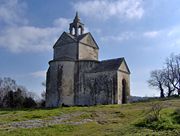
The Crypt of St. Benedict (12th century)
The crypt of St. Benedict is partly dug into the rock of the hill and partly built of massive stone walls, perfectly cut. It features a transpect with two absidioles, or small chapels, and a passage which leads to a small rotunda which is crowned with a cupola. The rotunda is surrounded by an ambulatory a tall, narrow circular corridor with a stone barrel vault. On its outer side, the ambulatory opens into five radiating chapels, each with its own window catching the eastern light, and its own small barrel-vaulted choir bay and semi-domed apse. The large number of small chapels allowed the large number of monks in the Monastery to quickly celebrate the morning mass.A striking feature of the crypt is the smooth quality of the stone work- the stones are perfectly cut and fitted, and their only texture is the slight rippling caused by dressing the stone with the help of a toothed hammer.
The Nave and Choir of the Abbatiale Church (12th century)
The massive church on top of the crypt has a single nave fourteen meters wide. It was designed to have five bays, but apparently because of a shortage of funds only two bays were constructed, and the west end was left unfinished.The nave is covered with slightly pointed barrel vaults supported by projecting traverse arches resting upon cruciform piers.
The apse, at the east end of the church, is semicircular, and has the same diameter as the width of the nave. It has an imposing semi-spherical dome with five flat ribs, and three small windows, slightly offset to one side. Perhaps because of the strong mistral and tramontane winds from the north, the nave has no windows on the north side.
The church has a relatively short transept, each wing ending in a small apsidiole.
There are three doorways on the south side of the church; one leading to the rock cemetery, one to abbot's lodging (now ruined); and one to the chapter house and the spiral stairway to the bell tower.
Two new chapels were added to the north side of the nave in the 15th century. One, which served as the sacristy
Sacristy
A sacristy is a room for keeping vestments and other church furnishings, sacred vessels, and parish records.The sacristy is usually located inside the church, but in some cases it is an annex or separate building...
, contains the 18th century lavabo
Lavabo
A lavabo is a device used to provide water for the washing of hands. It consists normally of a ewer or container of some kind to pour water, and a bowl to catch the water as it falls off the hands. In ecclesiastical usage it refers to both the basin in which the priest washes his hands and the...
, or washing basin, and the other protected the charters of the Abbey.
The Cloister (12th century)
The cloister was built to the south of the church. It was meant to reinforce the walls of the first four bays of the church, but these bays were never built. It is rectangular, 27 meters long and 24 meters wide. In the center is a cistern which collected rainwater through pipes and channels from the roofs of the monastery buildings.The north gallery is the oldest part of the cloister. The traverse arches are supported by brackets decorated with carvings of real and mythological beasts, including a tarasque
Tarasque
The Tarasque is a fearsome legendary dragon from Provence, in southern France, tamed in a story about Saint Martha. On 25 November 2005 the UNESCO included the Tarasque on the list of Masterpieces of the Oral and Intangible Heritage of Humanity....
. Some of the foliage-decorated columns show human heads looking through the foliage. The original sculpted capitals were repaired in the 19th century.
At the beginning of the east gallery is the tomb of the Counts of Provence, built to hold the remains of Count Raymond Berenger IV (died 1181). The only original Romaneque capitals are in this arcade, representing the Temptation of Christ
Temptation of Christ
The temptation of Christ is detailed in the Gospels of Matthew, Mark, and Luke. According to these texts, after being baptized, Jesus fasted for forty days and nights in the Judean desert. During this time, the devil appeared to Jesus and tempted him...
by a small devil with flaming hair; on the other side is an acrobat performing splits, and an apple, the symbol of temptation.
The west gallery was extensively altered by the Maurist monks in the 18th century, but the brackets have some of the most vivid carvings, showing the Mistral
Mistral (wind)
The mistral is a strong, cold and usually dry regional wind in France, coming from the north or northwest, which accelerates when it passes through the valleys of the Rhone and the Durance Rivers to the coast of the Mediterranean around the Camargue region. It affects the northeast of the plain...
wind, the moon, the sun and fire, and a mythical amphibious beast devouring a man. It also has 13th century graffiti depicting sailing ships and horses.
The south gallery is the most recent, and the carvings are the most realistic; a donkey, a monkey, a camel and an eagle are depicted on the brackets, and the columns show the Annunciation the crowning of the Virgin, and knights fighting.
The Chapter House was connected with the east gallery- here the monks gathered each morning to hear a chapter of the Rule of St. Benedict, and discussed the management of the Abbey. It is lit by a single oculus, or round window, and connected with the nave and by a stairway to the dormitory.
The Refectory, or dining room, connected with the south gallery through a Romanesque door decorated with a grotesque head of Tantalus
Tantalus
Tantalus was the ruler of an ancient western Anatolian city called either after his name, as "Tantalís", "the city of Tantalus", or as "Sipylus", in reference to Mount Sipylus, at the foot of which his city was located and whose ruins were reported to be still visible in the beginning of the...
,
The dormitory of the monks occupied the entire floor over the refectory, and was connected to it by two staircases.
The west gallery formerly connected to the cellar, bakery, bread oven, and guest rooms, which no longer exist.
The Pons de l'Orme Tower (14th century)
The tower was built by Abbot Pons de l'Orme beginning in 1369 to protect the Abbey from the rampaging Grand Compagnies (see chronology.) The tower is 26 meters high, and contained a well and a storeroom for provisions, and three floors in the upper level. The top is equipped with battlements, arrow slits and machicolationMachicolation
A machicolation is a floor opening between the supporting corbels of a battlement, through which stones, or other objects, could be dropped on attackers at the base of a defensive wall. The design was developed in the Middle Ages when the Norman crusaders returned. A machicolated battlement...
, designed to drop unpleasant things on the heads of attackers. The coat of arms of the Abbot, an elm tree with two angel-monks, is carved on the outside of the tower.
The Maurist Monastery (18th century)
